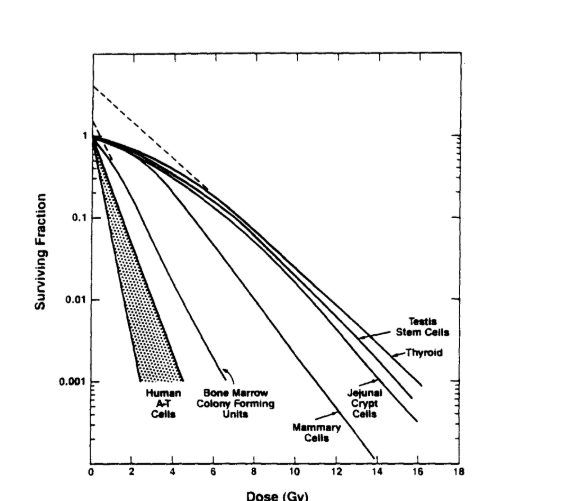Part 7: Cell Survival Curves
1/35
There's no tags or description
Looks like no tags are added yet.
Name | Mastery | Learn | Test | Matching | Spaced |
|---|
No study sessions yet.
36 Terms
What is the purpose of Cell Survival Curves?
To describe the relationship between the dose of radiation absorbed and the portion of irradiated cells that survive


The Vertical Axis of a Cell Survival Curve Describes
the fraction (or percent) of surviving cells
The Horizontal Axis of a Cell Survival Curve Describes
Dose
True or False: Dose-Relationship curves start from the bottom of the graph to the top, while Cell Survival Curves start from the top to the bottom
True
Cuz if no radiation has been received then all the cells survive cuz there is no dose, so you start at the top of the graph, then as you get a higher dose = cells start to die = curves go downwards
On the other hand, for Dose-Relationship curves: No dose = no effect
Dose has a (direct/inverse) relationship with cell survival
inverse
↑ dose = ↓ cells survive
Densely ionizing radiations aka
Particulate Radiations
e.g. e-, protons, neutrons, etc.
Shape of the curve for':
Densely Ionizing Radiation
EM radiations
Straight line (C)
Curvilinear (D)
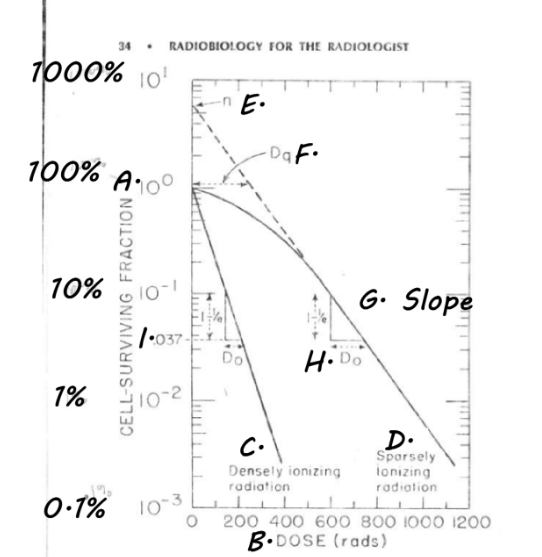
We deal more with (particulate/ EM ) radiation
EM radiation
We RARELY deal with particulate
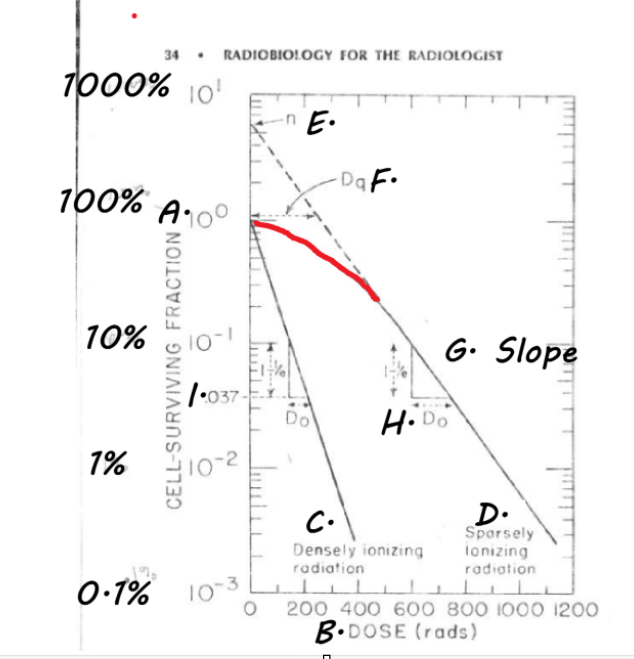
What is the part in red called?
SHOULDER
what does the shoulder represent?
sub-lethal damage
What is sub-lethal damage?
Damage that is NOT enough to KILL the cell. Cell is able to repair the damage done.
The BETTER the Type of Cell’s (e.g. RBC, WBC, skin cell, etc) repair ability the (smaller/bigger) the shoulder
Bigger
Explanation:
The bigger the shoulder = the more the cells were able to repair themselves
to cause cell death, there must usually be multiple “hits” on the DNA molecule, this describes
Multi-Target, Single Hit Model
FYI:
Multi-target- several critical structures on the cell’s genetic material (chromosomes)
Single hit: each critical site much be hit at least once
True or false: Single hits can usually be repaired
True: that is what the shoulder represents: the ability for such repair
True or False: In theory, a single hit could destroy the DNA molecule’s ability to repair itself
True
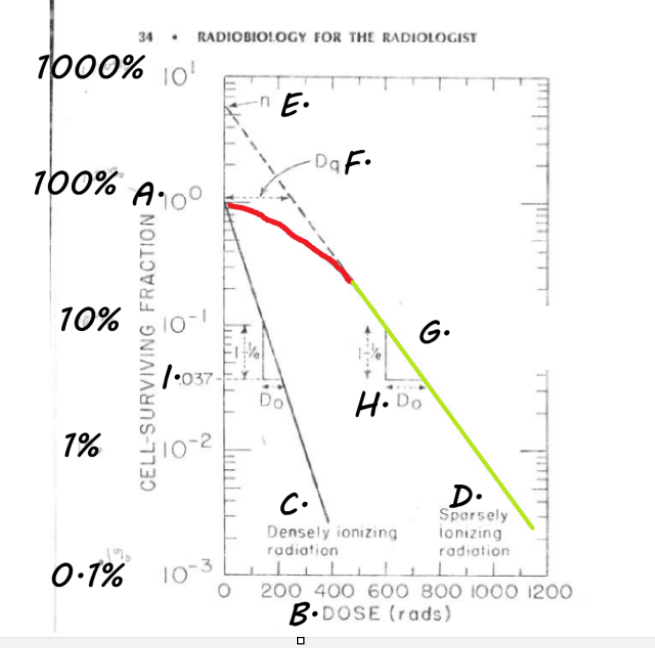
What is G?
Slope- straight line down from the shoulder
What does the Slope depict?
Linear cell kill
When the cell’s repair abilities can no longer keep up with the EXTRA damage done at higher doses
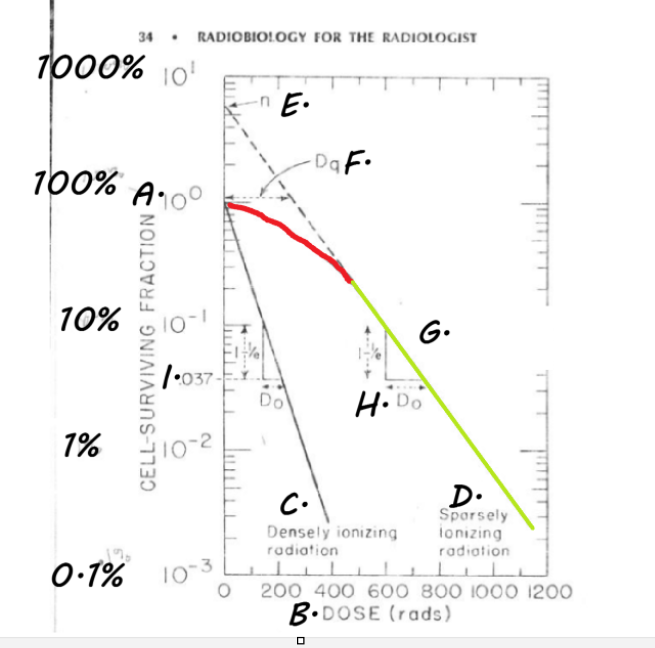
What is E?
n= extrapolation number
Extrapolation is a term almost synonymous with:
Interpolation
What does “n”- the extrapolation number represent?
Where the curve would be if there was no shoulder.; THEREFORE it measures the EXTENT of the shoulder (repair)
FYI:
It is an indirect way to measure the width of the shoulder, which tells us how much repair is going on

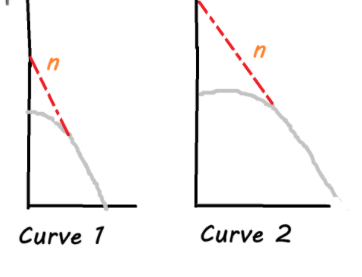
The following graphs show two different cell’s Cell Survival Curves. Which cell is more radioresistant? Justify your answer.
Curve 2 because its “extrapolation number ‘n’” is bigger
↑ extrapolation number = ↑ shoulder = better repair abilities = ↑ radioresistant
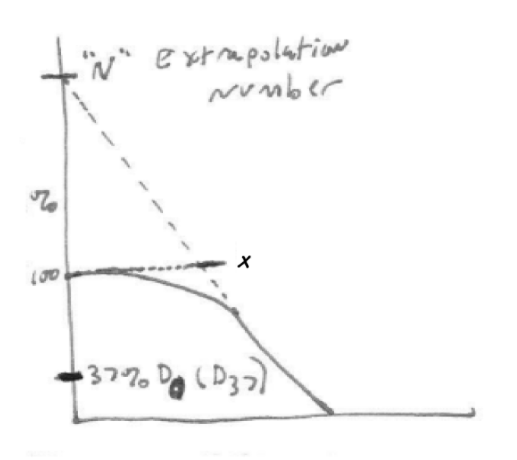
What is x?
Dq Threshold Dose - another way to measure repair ability

Dq “Threshold Dose” aka
Quasi-threshold dose
↑ Dq =
↑ Shoulder = ↑repair abilities = ↑ radioresistant
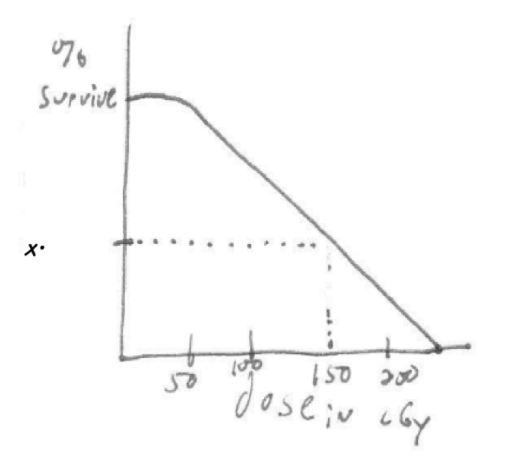
What is this? List all the names for it.
Do
D37
mean lethal dose
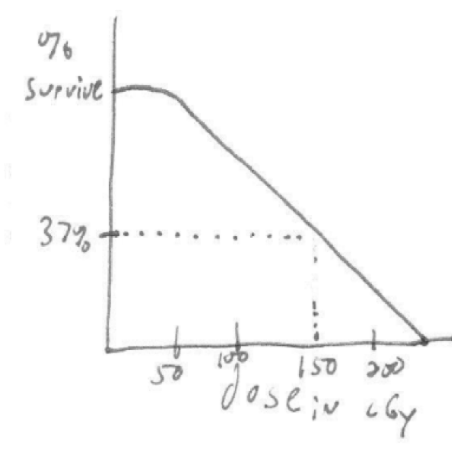
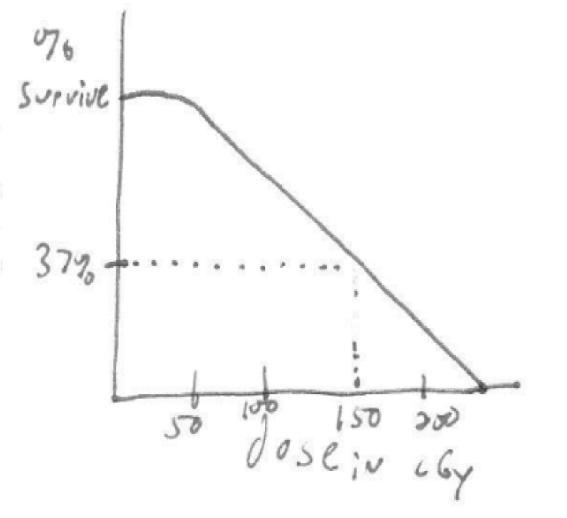
What is the mean lethal dose in this curve?
150 cGy
What are the 2 definitions of Mean Lethal Dose
the dose required to REDUCE the # of surviving cells to 37% of their original #
the dose required to AVERAGE one inactivating event (hit) per cell
True or False: 1 hit/ cell is what we what in RTT each day
True
What do we mean by 1 hit /cell?
Not all cancer cells get hit.
Some don’t get hit at all
Others get several hits
e.g. if we have 10 cells, we have 10 hits but not all cells get hit.
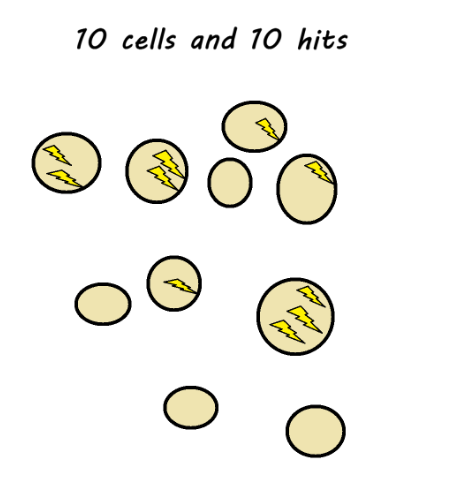
Where does the number 37% come out of?
if we do 1 average to 1 cell/ hit roughly 37% of the cells will survive
Day 1: radiate cells 37% survive
Day 2: 37% of 37% survive and so on
Typical Mean Lethal Dose for mammalians
100-200 cGy
(i.e. if you give 100-200 cGy each day you are average to 1 hit / cell)
Cell survival curves used to be determined (in vitro/ in vivo), but over the past ___ years, they have been determined (in vitro/ in vivo)
in vitro (petri dish) ; 30; in vivo (mice)
The 37% (mean lethal dose) is from radiation hitting cells randomly, so 37% of the cells survive. This is governed by a statistical law called:
Poisson Distribution
(we poissoning the cells)
True or False: A RBC will have the same shoulder as a WBC
False, different cells have different shoulders
True or False: Some cells have shoulders while other cells have no shoulders
False: all cells have the same shape. The only way the shape of the curve will look different is if you hit it with particulate radiation, they just go straight down. No shoulder
